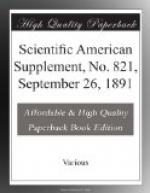The little place was always kept as exquisitely clean as the dainty, old-fashioned drawing room, and so vigilant was the overseeing care bestowed on every detail, that the most delicate and acute sense of smell could not detect the slightest abiding unpleasant odor. The paper bag was frequently changed, and every night the accumulated contents were burned; out of doors in the summer, and in the kitchen stove—after a strong draught had been secured—in the winter.
At stated times the deodorized mass of solid increment—in which there was not or ought not to have been any refuse paper to add useless bulk—was spaded, through the trap door, out of the box in the upper part of the vault, into a wheelbarrow, thrown upon the garden soil, and thoroughly incorporated with it. In this cleansing out process there was little to offend, so well had the ashes done their concealing deodorizing work.
In using this modified form of Moule’s invention, it is not necessary to dig a deep vault. The rector, given to forecasting, thought that some day his property might be bought by those who preferred the old style, but his brother, the doctor, not troubling about what might be, simply fitted his well made, four feet deep box, with its trap door, into a smoothly dug hole that exactly held it, and set the closet over it. In all other respects it was a model of his brother’s.
This last is within the reach of all, even those who live in other people’s houses; for, when they find themselves in possession of an unspeakably foul closet, they can cover up the old vault and set the well cleaned, repaired, fumigated closet upon a vault fashioned after the doctor’s plan. A stout drygoods box, which can be bought for a trifle, answers well for this purpose, after a little “tinkering” to form a trap door.
Of course, dry earth is by far the best deodorizer and absorbent, but when it cannot be easily and cheaply procured, well sifted wood or coal ashes—wood preferred—is a good substitute. The ashes must be kept dry. If they are not, they lose their absorbing, deodorizing powers. They must also be well sifted. If they are not, the cinders add a useless and very heavy bulk to the increment.
An ash sifter can be made by knocking the bottom out of a shallow box, studding the edge all round with tacks, and using them to cross and recross with odd lengths of stovepipe wire to form a sieve.—The Sanitarian.
* * * * *
THE HYGIENIC TREATMENT OF OBESITY.[1]
[Footnote 1: Translated by Mr. Jos. Helfman, Detroit, Mich.]
BY DR. PAUL CHERON.
In order to properly regulate the regimen of the obese, it is first necessary to determine the source of the superfluous adipose of the organism, since either the albuminoids or the hydrocarbons may furnish fat.
Alimentary fat becomes fixed in the tissues, as has been proved by Lebede, who fed dogs, emaciated by long fast, with meat wholly deprived of fat, and substituted for the latter linseed oil, when he was able to recover the oil in each instance from the animal; parallel experiments with mutton fat, in lieu of oil, afforded like results.




